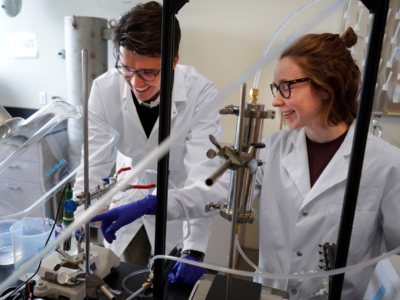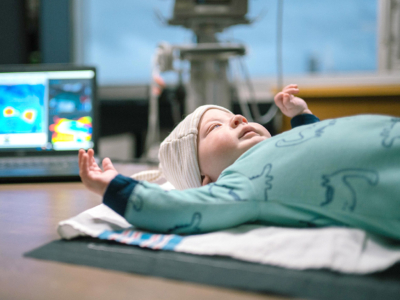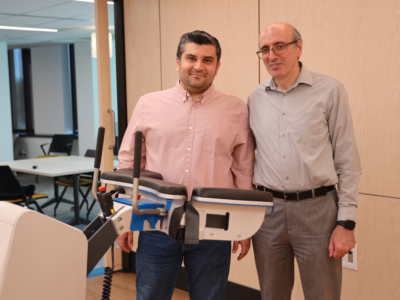Eighteen projects led by or with participation from researchers in the Faculty of Engineering and Design (representing 20 faculty members across all Departments and Schools) have been successful in their applications for CU COVID-19 Rapid Research Response Grants.
In response to COVID-19, Carleton University swiftly developed an internal funding opportunity to provide seed funding for individuals or teams of researchers for original, innovative, and time-sensitive research to propose solutions to the challenges posed by the COVID-19 pandemic, or to apply to external research grant competitions targeting the COVID-19 pandemic.
Research projects were required to have the potential to contribute to the global response to the COVID-19 pandemic, or to mitigate the spread of COVID-19 and/or its negative consequences on people and communities. The grant was open to all full-time tenured or tenure-track faculty members.
Successful projects featuring researchers from the Faculty of Engineering and Design include:
| Semi-Autonomous Mobile Robotic Systems for Remote Assessments of COVID-19 Patients Dr. Mojtaba Ahmadi (Mechanical and Aerospace Engineering) |
| This collaborative research project between Carleton University’s Advanced Mechatronics Laboratory (ABL) and the Children’s Hospital of Eastern Ontario (CHEO) proposes robotic remote patient assessment to enable physical distancing, thus preventing disease outbreaks. The ABL’s expertise in medical robotics will be complemented by CHEO’s medical expertise in developing and testing this technology. Carleton’s existing robotic platform will be enhanced by additional medical instrumentation, advanced sensing and control tools, teleconferencing capability, and the required hardware and software infrastructure. Moreover, small-size UV-based disinfection apparatus will be considered for integration. This short-term project focuses on developing a proof-of-concept platform and conducting preliminary experiments at CHEO’s simulation environment. This will allow medical researchers with various expertise to conduct early research in preparation for more systematic clinical trials to be funded by further joint research applications. |
| Development of Peptide Inhibitors of SARS-CoV-2: Human Protein Interaction Dr. Kyle Biggar and Dr. James Green (Systems and Computer Engineering) |
| The COVID-19 pandemic, caused by the SARS-CoV-2 virus, has led to catastrophic loss of life and the necessity to implement quarantines globally to contain the virus’s propagation. In order to reduce the transmission of the virus between people, three strategies can be used: wide-spread vaccination, wide-spread use of anti-viral medication, and social distancing (immediately applicable, though highly disruptive). Our work focuses on the second strategy by using algorithms developed here at Carleton University to study the novel coronavirus and to produce novel peptide-based anti-viral drugs designed to inhibit virus-human interactions. This research represents a collaboration between two bioinformatics labs: The Green Lab will focus on the computational goals, while the Biggar Lab will confirm and characterize novel-predicted targets using experimental techniques. By understanding and controlling the interactions that exist between the SARS-CoV-2 virus and humans, this research will identify new ways to disrupt the virus-host relationship. |
| Canadian Autonomous Rapid Test Center (CUCART) Dr. Scott Bucking (Civil and Environmental Engineering / Azrieli School of Architecture and Urbanism) |
| The Community Design Lab (CDLAB) recently completed development of a rapidly deployable, autonomous, tiny home. An industry partner approached CDLAB with a request to adapt the design for use as a decentralized COVID-19 testing facility. The purpose of the proposed project is a pedestrian flow study of the modified design, to increase testing capacity by maximizing the number of patients processed per hour. The placement of key areas will be coordinated through an iterative approach, accommodating social distancing limits and occupant separation, as required.
As governments reopen economies, the need for pre-screening populations will exceed projected test capacity. A rapidly deployable autonomous unit, or Centre for Unitary, Contained and Autonomous Rapid Testing (CUCART), with integrated equipment, could help meet this demand. In combination with an NSERC Alliance proposal for digital design of the facility, and support from an industry partner well-versed in medical testing, the CDLAB intends to develop and assess the CUCART. |
| Reopening Retail: Architectural Strategies for Adapting Retail Environments to Physical Distancing Protocols Dr. Zachary Colbert (Azrieli School of Architecture and Urbanism) |
| This research will develop adaptive architectural design standards and recommendations to accommodate physical distancing measures in Ottawa retail environments that will protect public health while bolstering customer confidence. According to Statistics Canada, nearly 3 in every 10 Canadian workers are employed in trades or manufacturing. Of the trades, retail is the largest sector of the Canadian economy, employing approximately 2.7 million people. Research outcomes will contribute to developing architectural design standards and recommendations for retailers in Canada and internationally that safely incorporate physical distancing practices into their stores. |
| Longitudinal Monitoring of Lung Function in COVID-19-Induced Pneumonia Dr. Jeff Dawson and Dr. Andy Adler (Systems and Computer Engineering) |
| Electrical Impedance Tomography (EIT) rapidly and non-invasively provides graphical and quantitative lung function data. Knowing where air is in the lungs during the rapid deterioration of ventilatory capacity is necessary for understanding COVID-19-induced acute respiratory distress syndrome (ARDS). We will use these funds for a longitudinal study (diagnosis to discharge) of 10 patients over the course of their stay in the hospital and/or ICU. We have two research objectives: 1) to obtain EIT data (imaging) to better understand the progressive changes in regional ventilation (pulmonary shunting) occurring in COVID-19 specific ARDS, and 2) to further develop and enhance existing software tools for the analysis of EIT data, to increase its accessibility and clinical usefulness. We will take advantage of our established collaborations with front-line physicians and nurses at The Ottawa Hospital and The Ottawa Hospital Research Institute for data collection, allowing our team to work remotely toward our goals. |
| Toward Crowd-Sourced and Anonymous Contact Tracing Dr. Babak Esfandiari (Systems and Computer Engineering) |
| This project will develop a database of social events and gatherings attended by people potentially infected with COVID-19, in order to trace the spread of disease and focus testing on those most likely to be infected. Contact tracing has proven to be useful for reducing the spread of disease and could be instrumental in re-opening the economy. The database must be developed in a very short time frame so it can be presented to interested stakeholders — such as healthcare providers and software companies — as soon as possible and adopted for immediate use. Once the system is deemed useful and usable, future developments include the ability to automatically populate the database by hooking onto existing contact apps that will detect and identify large gatherings where contact has taken place, such as sporting events, concerts, and religious gatherings, as a means of preventing community spread. |
| Social Wearables – Crowdsourcing eHealth Technology Dr. Paulo Fernando Rocha Garcia (Systems and Computer Engineering) |
|
Wearables are now commonplace as monitoring devices for personal health information. However, the COVID-19 pandemic has shown that we must move from a personal to a social approach to health. This social approach must be supported by adequate technology, beyond what is currently available.
We believe wearable technology will play a key role in preventing future pandemics by crowdsourcing health information (likely through connections to our phones), thereby creating networks of contact that help in identifying and preventing contagion, and correlating personal health information to identify suspected infections, etc. For this to be realized, we must address privacy concerns at a fundamental level of wearable hardware and software, and design trusted wearable devices with the required level of computational power and communication, whilst maintaining lasting battery life. This project will research the technologies that support social wearables towards a social response to the COVID-19 pandemic. |
| Border Protection for COVID-19 Through Symptom Analysis Dr. Chris Joslin (School of Information Technology) |
| The COVID-19 pandemic has shown that while Canada is capable of defending its borders against illegal immigration, smuggling, guns, and other nefarious unwanted elements, it is only able to deny entry to those carrying disease by almost completely shutting down borders (bar trade goods). And while Canadians are proud of their national health service, this same service faces tough challenges when dealing with pandemics such as COVID-19. Therefore, it is important for Canada to strengthen its borders to these viral agents and provide quarantine to carriers where necessary, to secure the health of its population while maintaining trade and tourist routes alike. This research program will deliver methods of monitoring the key health factors of people entering the country (whether returning or simply visiting) so that COVID-19, and future potential diseases, can be kept out of the country. |
| Airworthiness Effects of Decontamination Processes on Drone Aircraft Dr. Jeremy Laliberté (Mechanical and Aerospace Engineering) |
| In this project, we will examine industry-accepted decontamination methods and chemicals used in the traditional manned aviation industry and assess their applicability, operational impact, and potential to degrade the airworthiness of large and small remotely piloted aircraft systems (RPAS or “drones”). The short-term goal is to identify and develop an acceptable decontamination process for these aircraft for immediate deployment while identifying long-term design modifications and improvements to simplify decontamination of future drone aircraft of all types. |
| Assessment of Masks and Aerosol Characterization from Cough, Sneeze, Speech, and Breath Dr. Edgar Matida (Mechanical and Aerospace Engineering) |
| COVID-19 can be spread by sneezing, coughing, and possibly even through normal conversation. The proposed research comprises numerical, in vitro, and in vivo fundamental studies of the characterization (size and velocity) of droplets and aerosols during sneezing, coughing, talking, and breathing as functions of time and distance from the source. An adjustable cough and sneeze aerosol generator will be created and used to test filtration levels of popular designs of homemade masks. During the in vivo portion of the work (planned for when the present pandemic has subsided and social distancing regulations have eased), plume visualization using high-speed shadowgraph imaging techniques will be performed to complement the simultaneous measurement of aerosol size and velocity using phase Doppler anemometry at determined distances from the airborne material source. Numerical simulations of aerosol dispersion, validated against the experimental data, will provide a complete spatial characterization of the plumes. |
| Monitoring of SARS-CoV-2 in Wastewater to Minimize/Prevent Future Outbreaks Dr. Banu Örmeci (Civil and Environmental Engineering) |
| SARS-CoV-2 is present in the guts of COVID-19 patients and shed with their stool. As a result, the virus is present in raw (untreated) sewage and recent studies have shown that SARS-CoV-2 RNA can be detected in sewage much earlier than the first confirmed case in a community. Thus, monitoring of SARS-CoV-2 in sewage provides an effective tool for early warning surveillance and understanding the prevalence of the disease in a community. Until a vaccine is found, COVID-19 will likely come back in waves and there is a need for noninvasive, effective, and easy-to-employ monitoring tools to effectively manage future outbreaks. This research will monitor the SARS-CoV-2 RNA levels in raw sewage as an early warning surveillance tool and at wastewater treatment plants to investigate the presence, fate, and removal of the virus. |
| Point-of-Care Sensor Device for Early Stage Detection of COVID-19 Using Isothermal DNA Amplification Dr. Ravi Prakash (Electronics) |
| The COVID-19 pandemic has caused a global healthcare crisis which necessitates extensive, rigorous, and early stage screening of the virus. A significant challenge in monitoring community spread is that over 50% of carriers can be asymptomatic and still spread the infection. As a result, extensive testing at centralized laboratories would be challenging. Existing DNA and antibody biomarker-based COVID-19 tests have also been limited due to their complexity and dependence on benchtop instruments. There is a strong push towards designing rapid point-of-care (POC) nucleic acid test (NAT) systems to extract and amplify the viral RNA using improved DNA molecular probes to facilitate miniaturization and reduce screening time. Our interdisciplinary research team possesses expertise in POC NAT system design for influenza and arboviruses, and novel DNA biomarker discovery. We have initiated a sustainable partnership to significantly improve the existing sensor device design and incorporate novel isothermal DNA amplification primers for COVID-19 testing. |
| Automatic and Continuous Assessment of Blood Pressure Waveforms for Cardiac Health Monitoring of COVID-19 Patients Dr. Sreeraman Rajan (Systems and Computer Engineering) and Dr. Yuu Ono (Systems and Computer Engineering) |
| There is a need for non-invasive, inexpensive, disposable, automatic, continuous sensing of vital signs during the COVID-19 pandemic – both in hospitals and homes – due to the rapid deterioration of vital functions. This project will deliver a low-cost, continuous automatic sensing system for arterial functions, such as blood pressure waveforms, using a disposable ultrasonic sensor with machine-learning-based signal processing algorithms that can be used in hospitals and homes. Such a system is not currently available. The deliverables of this project will reduce the workload of the healthcare system, help health authorities to guide and manage better treatment plans, and provide home-care patients and caregivers with a tool to make better decisions regarding hospital visits. Furthermore, this system will improve safety for healthcare workers and for those in long-term care facilities. This system will have future use by helping in long-term monitoring of cardiac health beyond the pandemic and in emergency situations.Because of COVID-19, construction of fast-built temporary hospitals has gained significant attention. One effective solution for building such structures is to use modular construction with prefabricated components. However, currently there are not any specific design and construction guidelines for modular hospitals and the research in this area is limited. |
| Design and Performance Assessment of Fast-Built Hospitals with Modular Construction Dr. Vahid Sadeghian (Civil and Environmental Engineering) and Dr. Jeffrey Erochko (Civil and Environmental Engineering) |
| In the proposed project, a multi-disciplinary research team will systematically investigate the safety and performance of modular buildings under different operational conditions for pandemic response; propose a series of modular designs that vary in capacity, deployment range, and construction materials; and evaluate and optimize the designs using computer models.
The expected impacts of the project include providing accessible medical resources for remote northern and rural communities, ensuring safety and improving efficiency of temporary hospitals, reducing the risk to medical professionals and minimizing outbreaks, and providing unique training and highly employable skills for HQP. |
| Are they Effectively Learning? Enhancing Student Learning Experience Using LMS Analytics Amid and Post-COVID-19 Pandemic Dr. Omair Shafiq (School of Information Technology) |
| In the unprecedented times of the COVID-19 pandemic, education delivery through online learning management systems (LMS) has become crucial for educational institutions, now more than ever. Online delivery of education has benefits and challenges. One of the challenges is to find out if students are effectively learning and are connected with course material and, eventually, with their study program. In this research, we will design and develop a solution that will seamlessly monitor and track engagement patterns and learning experiences of students with course materials via online LMS. Our research will allow instructors, academic support staff, and students to gain deeper insights into student interaction, engagement, and learning experience through online LMS. The proposed research will also open up new possible ways to carry out early predictions of students who may be at risk of failing, thus allowing educators to take measures to improve student performance. |
| A Secure Privacy-Preserving Quarantine Notification System Dr. Wei Shi (School of Information Technology) and Dr. Jean-Pierre Corriveau |
| Due to a large number of asymptomatic carriers, the COVID-19 contagion is complex to monitor. Consequently, confirmed patients, as well as potentially infected individuals, are required to quarantine in order to control the spread of the virus. When a person is confirmed infected, a Contact Tracing System (CTS) is used by health authorities to determine this person’s whereabouts and obtain a list of individuals with “close” encounters so these individuals can be advised to self-quarantine. Several countries – such as China, South Korea, and Singapore – have developed and already use CTSs. However, these CTSs do not preserve the privacy of their users. That is, health authorities keep track of everyone’s whereabouts and can identify confirmed cases and their “close” contacts. Such an approach is not acceptable in Europe and North America. Consequently, several CTS proposals have been put forth to improve privacy. Proprietary closed-source solutions (e.g., from Apple/Google) are not acceptable in light of recent breach-of-privacy scandals. Some have inherent security vulnerabilities. Others (e.g., from UK’s NHSX and from the MILA lab in Montreal) require human intervention.
We have developed a Privacy-Preserving Quarantine Notification System. Through the use of Bluetooth and WiFi-enabled mobile devices, a user can receive a notification to quarantine if this user has encountered a confirmed COVID-19 patient 14 days before or after the lab confirmation date of this patient. A future version will also support IoT sensors. Our system is the only one we know that fulfills the following requirements: 1) secure (i.e., resilient to cyber attacks) 2) fully automated (i.e., not reliant on human intervention, except for its easy installation) 3) privacy preserving (i.e., prevents unlawful identification of an individual) 4) efficient (i.e., quarantine notifications must be timely) The guarantees of our system with respect to security and privacy favour its widespread adoption by Canadians, which, in turn, will ensure we stop the spread of the virus and successfully restart our economy. |
| COVID-19 – Design of Long-Term Care Homes (LTC) – Learning for the Future Dr. Chantal Trudel (School of Industrial Design) |
| The appropriate design of long-term care (LTC) homes is crucial in balancing infection prevention and control (IPAC) with residents’ quality of life and care, particularly during pandemic conditions such as COVID-19. While hospital IPAC protocols are relatively well-established, LTC protocols are not well developed and may not “fit,” and may even clash, with the unique characteristics of LTC. To address this, and support the redevelopment of Canada’s aging LTC infrastructure, we will develop short-term and long-term design studies focused on IPAC in LTC to explore front-line cognitive aids that can be readily deployed to support healthcare workers, as well as concepts to support future new builds and redevelopments of LTC homes. Such studies will be instrumental in helping us break ground in understanding the impact of COVID-19 in LTC homes and will also help provide impetus to build a dedicated program at Carleton focused on design and engineering for LTC. |
| Platform for Experimentation with Indoor Spatial Models of COVID-19 Dr. Gabriel Wainer (Systems and Computer Engineering) |
| In recent years, we built various simulation models based on the traditional Susceptible-Infected-Recovered (SIR) equations that are being used worldwide to predict the pandemic dynamics. We also have experience on integrating simulations and complex spatial visualization engines to allow decision makers to study how the virus spreads.
This research will study how viruses expand indoors. We will use detailed 3D models of the buildings on campus and adaptations of the SIR model for indoor environments. We will also study how the virus expands on larger areas. We will use Geographical Information Systems and Carleton’s Digital Campus map to build spatial versions of the SIR model with adaptations and improvements. The models will be available through the web for remote collaboration and for use by decision makers. This tool will permit studying different strategies for returning to campus at the end of the pandemic and for dealing with future outbreaks. |
Wednesday, June 3, 2020 in Architecture, Biomedical Engineering, Civil and Environmental Engineering, Competitions and Awards (Internal), Connected and Autonomous Vehicles, COVID-19, Electronics, General, Health, Industrial Design, Information Technology, Mechanical and Aerospace Engineering, Research, Systems and Computer Engineering, Water
Share: Twitter, Facebook



